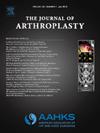皮质类固醇相关性股骨头坏死患者多灶性骨坏死的患病率和危险因素增加:一项为期15年的多中心研究
IF 3.8
2区 医学
Q1 ORTHOPEDICS
引用次数: 0
摘要
背景:多灶性骨坏死(MFON)是一种影响多个骨部位的罕见疾病,流行病学资料有限。本研究使用来自日本多中心哨点监测系统的数据,调查了bb0 ~ 15岁皮质类固醇相关性股骨头坏死(ONFH)患者发生MFON的频率、趋势和危险因素。方法:对2009 ~ 2023年658例患者的资料进行分析。MFON被定义为涉及三个或更多独立解剖部位的骨坏死。在三个五年期间评估了MFON的频率和趋势。MFON的危险因素分析使用2014年以后的数据,当时有吸烟史数据。将除股骨头外无坏死的组定义为非MFON组,比较MFON组和非MFON组的人口学特征和合并症。采用单因素和logistic回归分析对危险因素进行分析。结果:全期MFON发生率为5.3%,随时间延长发生率显著增高(分别为1.6、7.4、8.0%;P < 0.01)。膝关节是骨坏死最常见的部位,所有患者均累及膝关节。与非MFON组相比,MFON组患者更年轻(P < 0.001),女性患者更多(P < 0.05),系统性红斑狼疮(SLE)和血液学肿瘤患者明显更多(P < 0.05和P < 0.01)。MFON的独立危险因素包括年龄< 40岁(P < 0.05)、SLE (P < 0.05)、血液学肿瘤(P < 0.001)。结论:皮质激素相关ONFH患者发生MFON的频率为5.3%。年轻患者、SLE患者或血液学肿瘤患者发生MFON的风险较高,应考虑进行MFON筛查。本文章由计算机程序翻译,如有差异,请以英文原文为准。
Increasing Prevalence and Risk Factors for Multifocal Osteonecrosis in Patients Who Have Corticosteroid-Associated Osteonecrosis of the Femoral Head: A 15-Year Multicenter Study
Background
Multifocal osteonecrosis (MFON) is a rare condition affecting multiple bone sites, with limited epidemiological data available. This study investigated the frequency, trends, and risk factors for MFON in patients aged > 15 years who had corticosteroid-associated osteonecrosis of the femoral head (ONFH) using data from a multicenter sentinel monitoring system in Japan.
Methods
Data from 658 patients between 2009 and 2023 were analyzed. The MFON was defined as osteonecrosis involving three or more separate anatomical sites. The frequency and trends of MFON were assessed across three 5-year periods. The risk factors for MFON were analyzed using data from 2014 onward, when smoking history data became available. The group with no necrosis other than that in the femoral head was defined as the non-MFON group, and the demographics and comorbidities were compared between the MFON and non-MFON groups. The risk factors were analyzed using univariate and logistic regression analyses.
Results
The frequency of MFON was 5.3% during the entire period and increased significantly over time (1.6, 7.4, and 8.0%; P < 0.01). The knee joint was the most common site of osteonecrosis, and all patients had knee joint involvement. The MFON group was younger (P < 0.001) and had more women (P < 0.05) than the non-MFON group and had significantly more patients who had systemic lupus erythematosus (SLE) and hematological tumors (both P < 0.01). The independent risk factors for MFON included age < 40 years (P < 0.05), SLE (P < 0.05), and hematological tumors (P < 0.001).
Conclusions
The frequency of MFON in patients who had corticosteroid-associated osteonecrosis of the femoral head was 5.3%. Young patients, those who have SLE, or those who have hematological tumors are at a higher risk of MFON and should be considered for MFON screening.
求助全文
通过发布文献求助,成功后即可免费获取论文全文。
去求助
来源期刊

Journal of Arthroplasty
医学-整形外科
CiteScore
7.00
自引率
20.00%
发文量
734
审稿时长
48 days
期刊介绍:
The Journal of Arthroplasty brings together the clinical and scientific foundations for joint replacement. This peer-reviewed journal publishes original research and manuscripts of the highest quality from all areas relating to joint replacement or the treatment of its complications, including those dealing with clinical series and experience, prosthetic design, biomechanics, biomaterials, metallurgy, biologic response to arthroplasty materials in vivo and in vitro.
 求助内容:
求助内容: 应助结果提醒方式:
应助结果提醒方式:


